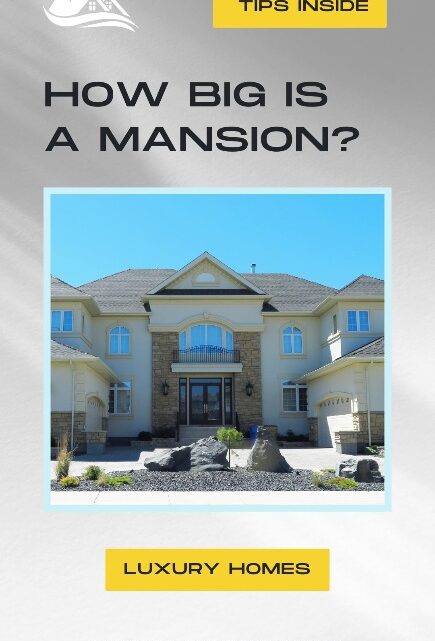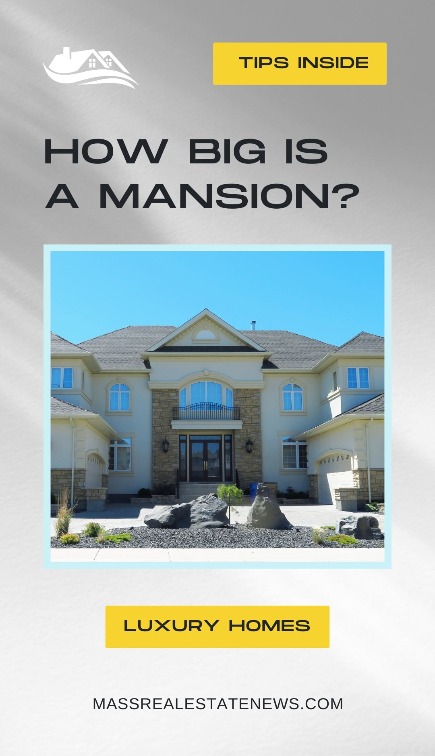When defining a mansion, square footage plays a crucial role. In Massachusetts, a manor generally has a minimum of 7,000 square feet of living space. However, this is a loose figure, with some thinking it’s lower and others higher. As a Realtor, I’ve often heard 5,000 square feet thrown around. That’s too small in my mind. Many McMansions fall into the 5,000-square-foot range – we will get into that further.
The point is it’s a massive property that few can imagine living in. These grand residences boast both size and luxurious amenities like multiple rooms, purpose-built areas, and top-notch materials.
However, it’s essential to differentiate between genuine mansions and imitations like McMansions, which lack the quality and design criteria. Another miniature luxury option is the jewel-box house.
Understanding square footage in the real estate market reveals intriguing trends and influences. We will examine some of the defining characteristics of Massachusetts mansions.
What Makes a House a Mansion in Massachusetts?
When defining a house as a mansion, several factors come into play. These factors exceed size and encompass various elements of these prestigious residences’ grandeur and luxury. Maximum Real Estate Exposure is a comprehensive resource for what makes a house a mansion.
Let’s review some of the standard characteristics.
Size Requirements for Mansions
In Massachusetts, mansions are typically characterized by extensive square footage. While no strict definition exists, a manor is generally expected to have at least 7,000 square feet of living space. This expansive size allows for generous rooms and ample living areas that exude opulence and luxury.
Luxury Features and Amenities in Mansions
Size alone does not define a mansion; the luxurious features and amenities genuinely set it apart. Mansions often boast numerous bedrooms, bathrooms, and specialized rooms built for specific purposes, such as game rooms, home theaters, and gyms.
These additional spaces enhance the residents’ overall lifestyle and entertainment opportunities, reflecting the epitome of luxury living.
Significance of High-Quality Materials in Mansions
A crucial aspect of building a mansion lies in the materials used. High-quality materials such as premium wood and superior stone are expected in mansion construction. These materials not only elevate the aesthetic appeal but also ensure durability and longevity, further enhancing the overall value and grandeur of the property.
Understanding McMansions in Massachusetts
McMansions are a distinct architectural phenomenon that has gained popularity in recent years. From experience as a Realtor, McMansions have become an everyday part of the real estate landscape. They have essentially become a “dime a dozen.”
Many Massachusetts home builders construct McMansion. While the cost of building a home such as this is more expensive, they are nothing compared to the price of a mansion.
Let’s explore authentic mansions’ definitions, characteristics, and critical differences. And the standard features and pitfalls associated with McMansions.
Definition and Characteristics of McMansions
Mcmansions, often called “cookie-cutter” houses, are typically large-scale homes designed to mimic the grandeur of authentic mansions but without delivering the same quality and craftsmanship. They are characterized by the following:
- Massive square footage, often exceeding the average square footage of traditional homes
- Impressive but usually “over-the-top” architectural features, such as turrets, multiple garages, and excessive rooflines
- Mass-produced design elements lacking individuality or unique architectural style
- Inclusion of lower-grade materials to lower construction costs
Toll Brothers would be the perfect example of a builder constructing McMansions in the Metrowest area of Massachusetts. Many of the homes in their neighborhoods look like rubber-stamped carbon copies. Others have minor distinguishing characteristics.
These homes are perfect for buyers who put square footage over the ultimate quality. They also offer outstanding layouts, which isn’t always true with McMansions in Massachusetts. If you like brick-front homes, you’ll probably love the look of a Toll Brothers home.
Differentiating McMansions from Authentic Mansions
It’s crucial to distinguish McMansions from authentic mansions based on specific criteria. While actual estates boast exceptional quality and luxury, McMansions falls short in numerous areas. The critical distinctions between the two include:
- Authentic mansions prioritize meticulous craftsmanship and high-quality materials, while McMansions often utilize cheaper alternatives.
- Authentic mansions embody a specific architectural style, reflecting historical significance, while McMansions lack architectural cohesiveness and originality.
- Authentic mansions are typically custom-built, whereas McMansions follow a standardized, mass-produced approach.
Standard Features and Pitfalls of McMansions in Massachusetts
Massachusetts McMansions tend to exhibit standard features often associated with their design approach. However, these characteristics can also pose pitfalls for homeowners. Some of the standard features and drawbacks of McMansions include:
- Excessive square footage can lead to wasted space and increased maintenance costs.
- Unbalanced design elements create a visually overwhelming and disjointed appearance.
- Lack of functional layouts, with impractical room configurations and inefficient use of space.
- Focus on aesthetic appeal over practicality, resulting in shallow or superficial architectural design choices.
Understanding the concept of McMansions is crucial in the real estate market, especially for buyers seeking true quality and architectural integrity in their homes.
Miniature Luxury: Jewel-Box Houses
Regarding luxury residences, not all grand homes need to be massive mansions. Introducing jewel-box houses, these unique dwellings offer a taste of luxury on a smaller scale. Let’s delve into the world of jewel-box houses and explore their distinct characteristics and how they compare to traditional mansions.
Introduction to Jewel-Box Houses
Jewel-box houses are exquisite miniatures of luxury homes that captivate with their intricate details and refined design. Although smaller than sprawling mansions, these homes are crafted to perfection, exuding elegance and sophistication. They are bigger houses that many buyers desire but not so large they become unmanageable financially or otherwise.
Unique Traits of Jewel-Box Houses
What sets jewel-box houses apart is their attention to detail. Every nook and cranny is carefully curated to showcase the finest craftsmanship. From ornate moldings and hand-carved accents to luxurious finishes, these homes offer remarkable artistry.
Despite their smaller footprint, jewel-box houses cleverly maximize space utilization, creating a cozy yet lavishly appointed environment. Expect to find high-end fixtures, custom-designed elements, and integrated technology that seamlessly blends functionality and luxury.
Comparing Jewel-Box Houses to Traditional Mansions
While jewel-box houses and traditional mansions offer luxury, they cater to different preferences and lifestyles. Jewel-box houses offer a more intimate living experience, ideal for those seeking refined elegance on a smaller scale.
- Jewel-box houses prioritize intricate details and exquisite craftsmanship.
- Traditional mansions focus on grandeur and expansive living spaces.
- Jewel-box houses maximize space utilization to create a cozy yet luxurious ambiance.
- Traditional mansions boast expansive rooms and multiple amenities.
- Jewel-box houses showcase refined design and attention to detail.
- Traditional mansions impress with their size and opulence.
Whether one chooses a jewel-box house or a traditional mansion, both offer the allure of luxury living, catering to discerning individuals seeking exceptional residences that reflect their refined taste.
Exploring Square Footage in the Real Estate Market
In the real estate market, square footage plays a significant role in determining the value and desirability of a property. Let’s delve into the various aspects of square footage and its influence on real estate.
Average Square Footage of Homes in the United States
When considering the average square footage of homes in the United States, it’s important to note that there is a considerable range. As of 2023, the average size of homes in the country falls between 1,600 and 2,000 square feet. This range includes a variety of housing types, from apartments to single-family houses.
Square Footage Trends in Luxury Property Market
Within the luxury property market, square footage takes on a new dimension. With their grandeur and opulence, Mansions surpass the average square footage of traditional homes. As mentioned, a mansion generally has at least 7,000 square feet of living space. However, it’s worth noting that the size of estates can vary significantly, with some exceeding 10,000 or even 20,000 square feet.
Furthermore, a trend towards more significant luxury properties is growing, emphasizing spaciousness and extravagant living spaces. Buyers in the luxury market seek extensive square footage to accommodate lavish amenities and showcase their style.
Calculating Square Footage and Its Influence on Property Insurance
Accurately calculating square footage is crucial not only for determining the market value of a property but also for insurance purposes. Insurance companies take square footage into account when evaluating coverage and premiums.
The larger the square footage, the higher the replacement costs and potential liability in case of damage or loss.
When calculating square footage, it’s essential to consider the livable space, excluding areas such as garages, unfinished basements, or outdoor patios. Proper measurements and adherence to industry standards ensure the accuracy of square footage calculations.
Key points to remember:
- The average size of homes in the United States ranges from 1,600 to 2,000 square feet.
- Touring homes like mansions and McMansions requires a more careful approach as you can easily miss many of the property’s features. Be prepared to ask the real estate agent questions when viewing these homes.
- Mansions typically boast at least 7,000 square feet, surpassing the average home size. Most mansions are much more significant – 10,000-20,000 square feet are commonplace.
- More extensive square footage is a growing trend in the luxury property market, reflecting a desire for spacious and extravagant living spaces.
- Accurate square footage calculation is essential for insurance, considering replacement costs and liability.
Final Thoughts About Mansions in Massachusetts
Real Estate Market Insights for Mansions
To stay updated on the current trends and market conditions for mansions, consulting real estate market insights tailored explicitly to luxury properties is beneficial. These insights provide valuable information regarding pricing trends, market activity, and regional variations.
You can make informed decisions about buying or selling mansions by staying informed.
Recommended Reading on Luxury Mansions
Exploring recommended reading materials can expand your knowledge further if you are interested in luxury mansions. Numerous books and publications are available that delve into the world of architectural design, historical significance, and lavish features of mansions. These resources provide insights and inspiration for those looking to appreciate the grandeur of these magnificent estates.
By utilizing these additional resources and tools, you can enhance your understanding of square footage in mansions, navigate the real estate market, and deepen your knowledge of luxury residences.










No Comment